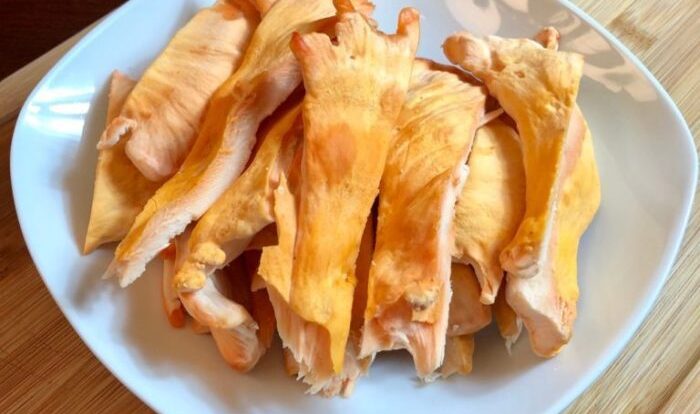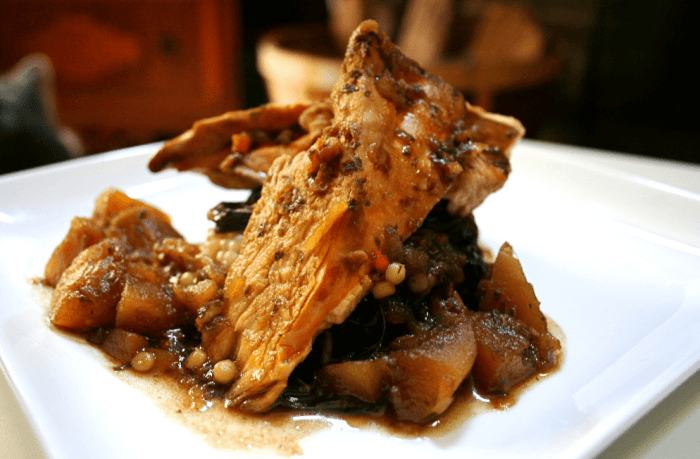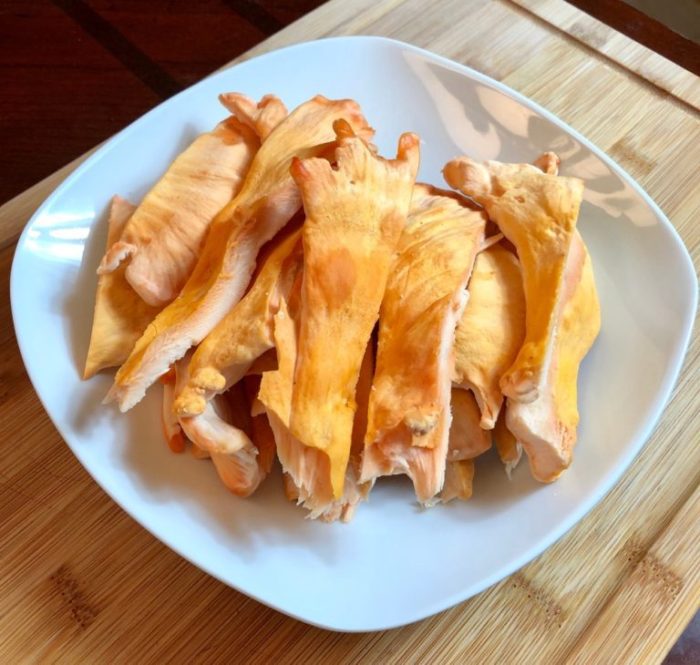
Chicken of the woods recipe – Embark on a culinary journey with the fascinating chicken of the woods mushroom, renowned for its delectable flavor and impressive nutritional value. This versatile fungus offers a plethora of recipe variations, health benefits, and culinary applications, making it a must-try for any foodie or health enthusiast.
From stir-fries to soups and salads, chicken of the woods lends its unique umami-rich flavor to a wide range of dishes. Its nutritional profile boasts vitamins, minerals, and antioxidants, making it a delicious and nutritious addition to your diet.
Recipe Variations
Chicken of the woods is a versatile mushroom that can be cooked in a variety of ways. Here are a few popular recipes, categorized by cooking method:
Stir-fries
- Chicken of the Woods Stir-Fry with Vegetables: This dish is a quick and easy way to cook chicken of the woods. Simply stir-fry the mushrooms with your favorite vegetables, such as broccoli, carrots, and onions.
- Chicken of the Woods and Tofu Stir-Fry: This vegetarian stir-fry is a great way to get your protein. Tofu is a good source of protein and iron, and it pairs well with the earthy flavor of chicken of the woods.
Soups, Chicken of the woods recipe
- Chicken of the Woods Soup: This soup is a hearty and flavorful way to warm up on a cold day. It’s made with chicken of the woods, vegetables, and a creamy broth.
- Chicken of the Woods and Wild Rice Soup: This soup is a twist on the classic wild rice soup. It’s made with chicken of the woods, wild rice, and vegetables.
Salads
- Chicken of the Woods Salad: This salad is a light and refreshing way to enjoy chicken of the woods. It’s made with chicken of the woods, greens, and your favorite dressing.
- Chicken of the Woods and Goat Cheese Salad: This salad is a bit more decadent than the previous one. It’s made with chicken of the woods, goat cheese, and greens.
Health Benefits and Nutritional Value

Chicken of the woods is a nutritionally rich mushroom packed with vitamins, minerals, and antioxidants. It is an excellent source of fiber, which is important for digestive health and maintaining a healthy weight.
Chicken of the woods is also a good source of B vitamins, including niacin, riboflavin, and thiamin. These vitamins are essential for energy production, nerve function, and metabolism.
Immune System Support
Chicken of the woods contains several compounds that have been shown to support the immune system. These compounds include polysaccharides, which are complex carbohydrates that have been shown to enhance the activity of immune cells.
Anti-inflammatory Properties
Chicken of the woods also has anti-inflammatory properties. These properties are due to the presence of compounds called ergothioneine and maitake mushroom extract. These compounds have been shown to reduce inflammation in the body.
If you’re based in the Southwest, the Pima County Mycological Society offers an alternative chicken of the woods recipe that incorporates local ingredients and flavors. Their recipe features a unique blend of spices and herbs that will enhance the natural taste of the mushroom.
Whether you’re a seasoned forager or just starting out, these recipes will provide you with all the information you need to prepare a delicious and memorable chicken of the woods dish.
Identification and Foraging Tips

Chicken of the woods, a vibrant and delectable mushroom, boasts an array of characteristics that make it a distinct and recognizable species. Its large, shelf-like shape, reminiscent of a chicken’s plumage, sets it apart from other fungi.
Upon closer examination, its texture is firm and meaty, with a bright orange to yellow coloration that varies depending on its maturity. Chicken of the woods thrives in moist, shady areas, often found growing on dead or decaying hardwood trees, especially oak and maple.
Lookalikes and Potential Risks
While chicken of the woods is generally considered safe to consume, it is crucial to exercise caution when foraging due to its potential lookalikes. One such lookalike is the sulfur shelf mushroom, which possesses a similar shelf-like shape but has a more muted orange or yellow color and a sulfurous odor.
Consumption of the sulfur shelf mushroom can cause stomach upset and other adverse reactions.
To avoid confusion, it is essential to thoroughly examine the mushroom’s characteristics, including its appearance, texture, and habitat. Consulting with experienced mushroom foragers or referring to reliable field guides is highly recommended for accurate identification.
When it comes to foraging for edible mushrooms, chicken of the woods is a must-try. This vibrant fungus is known for its distinctive appearance and savory flavor. If you’re looking for a delicious way to prepare this delicacy, check out the chicken of the woods recipe from Sonoma County Mycological Association.
With step-by-step instructions and helpful tips, you’ll be able to create a mouthwatering dish that will impress your friends and family.
Culinary Applications and Flavor Profile
Chicken of the woods is a versatile culinary mushroom with a wide range of applications. Its meaty texture and savory flavor make it a popular choice for vegetarians and meat-eaters alike.
As a meat substitute, chicken of the woods can be used in soups, stews, and stir-fries. Its ability to absorb flavors makes it a great addition to marinades and sauces. The mushroom can also be grilled, roasted, or sautéed as a side dish or appetizer.
Flavor Profile
Chicken of the woods has a unique flavor profile that is often described as umami, earthy, and slightly spicy. The umami flavor comes from the presence of glutamates, which are amino acids that give food a savory taste. The earthy flavor is due to the mushroom’s high mineral content, while the spiciness is caused by the presence of capsaicin, the same compound that gives chili peppers their heat.
Preservation and Storage Techniques: Chicken Of The Woods Recipe

Chicken of the woods, with its vibrant colors and unique flavor, can be preserved and stored using various techniques to extend its shelf life and maintain its quality. Proper preservation methods ensure that you can enjoy this delicious mushroom all year round.
Drying
Drying is an effective way to preserve chicken of the woods and extend its shelf life significantly. Sliced mushrooms should be dried in a dehydrator or air-dried in a warm, well-ventilated area. Once completely dry, store them in airtight containers in a cool, dry place.
Dried chicken of the woods can be rehydrated by soaking in warm water before cooking.
Freezing
Freezing is another convenient method to preserve chicken of the woods. Clean and slice the mushrooms, then blanch them in boiling water for a few minutes. Drain and pat dry before freezing in airtight containers or freezer bags. Frozen chicken of the woods can be stored for several months and can be thawed in the refrigerator or microwave before cooking.
Pickling
Pickling is a great way to preserve chicken of the woods while adding a tangy flavor. Clean and slice the mushrooms, then combine them with a mixture of vinegar, water, sugar, and spices. Store the pickled mushrooms in airtight jars in the refrigerator for up to a month.
Pickled chicken of the woods can be enjoyed as a condiment or added to salads and sandwiches.
Final Conclusion

Whether you’re foraging for this wild mushroom or purchasing it from a specialty market, incorporating chicken of the woods into your culinary repertoire is a rewarding experience. Its versatility, health benefits, and exceptional flavor make it a standout ingredient that will delight your taste buds and nourish your body.
Question Bank
What are the health benefits of chicken of the woods?
Chicken of the woods is rich in vitamins, minerals, and antioxidants, which may support immune function, reduce inflammation, and protect against chronic diseases.
How can I identify chicken of the woods?
Look for bright orange to yellow shelf-like clusters with a velvety texture. Avoid mushrooms with white gills or a strong odor, as these may be poisonous lookalikes.
How do I cook chicken of the woods?
Chicken of the woods can be cooked in various ways, including stir-frying, sautéing, grilling, or roasting. It can also be used as a meat substitute in soups, stews, and casseroles.